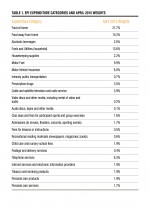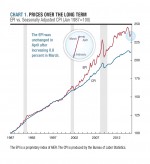Everyday Prices Stabilize
After several volatile months, gasoline prices stabilized in April. Both regular and midgrade increased less than 0.1 percent, while premium moved lower by 0.1 percent. Gasoline prices have decreased 31.7 percent over the past 12 months. Other energy prices were down, likely due to spring weather, with utilities and fuel oil decreasing 3.4 percent and 8.4 percent, respectively.
Food-at-home decreased 0.1 percent in April because increases for seafood and fresh fruits were offset by decreases in pork and dairy products. Seafood prices increased 1.2 percent in April with processed seafood increasing 2.5 percent and frozen seafood increasing 3.2 percent. Fresh fruits increased 1.3 percent because of a 3.4 percent increase in the price of citrus fruits. Offsetting these increases were a 2.7 percent decrease in the price of pork and a 1.2 percent decrease in milk.
Prices for personal care were mixed in April. Personal-care services increased 0.1 percent but personal-care products decreased 0.4 percent. Within personal-care products, dental, and shaving products decreased 0.5 percent and cosmetics decreased 0.2 percent. Health care items such as prescription drugs and medical supplies were unchanged in April but have increased 5.6 percent over the past 12 months. Other price changes included group sports and exercise, which increased 0.6 percent. Finally, if you needed child care in April, prices increased 0.8 percent and have increased 4.2 over the past 12 months.
About the EPI
AIER’s Everyday Price Index (EPI) measures the changing prices of frequently purchased items like food and utilities. We do this by selecting the prices of goods and services from the thousands collected monthly by the Bureau of Labor Statistics in computing its Consumer Price Index. The EPI basket contains only prices of goods and services that Americans typically buy at least once a month, excluding contractually fixed purchases such as mortgages. Our staff economists weight each EPI category in proportion to its share of Americans’ average monthly expenditures. In order to better reflect the out-of-pocket prices that consumers experience on a daily basis, the EPI does not seasonally adjust prices.
To learn more about our methodology, view the weights assigned to each component, and browse past EPI updates, visit AIER’s EPI Methodology page.






